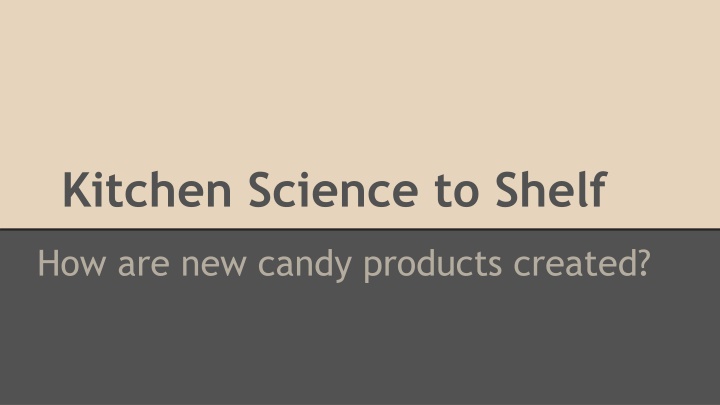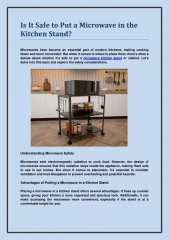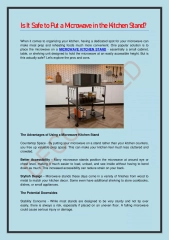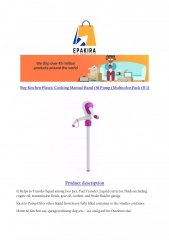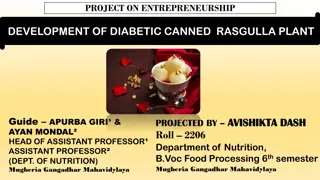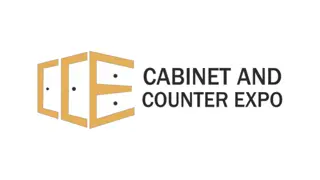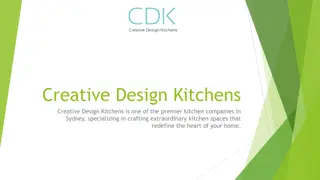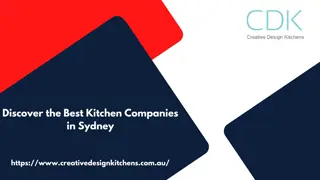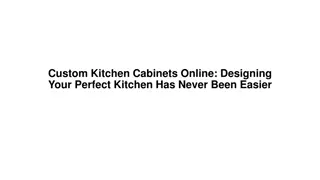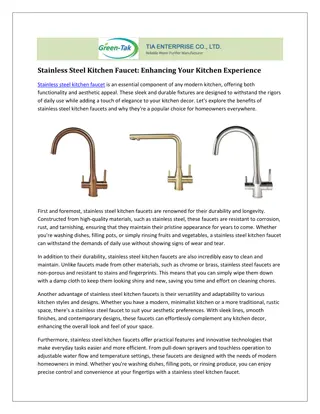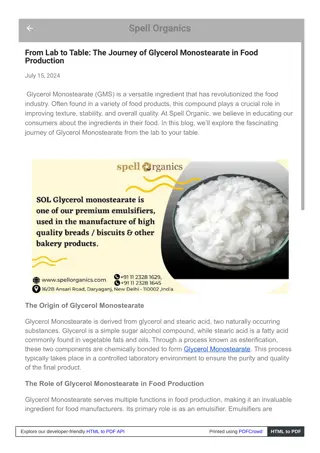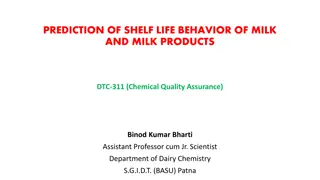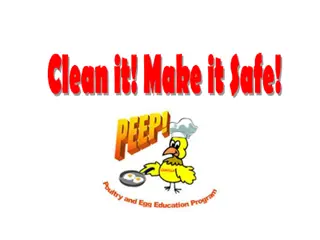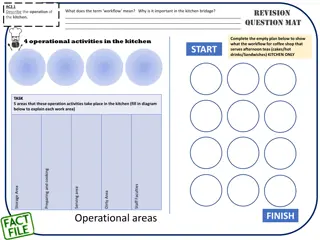Kitchen Science to Shelf
Explore the journey of creating new candy products, from forming sugar crystals to understanding food chemistry. Engage in hands-on experiments, group discussions, and projects to delve into the chemical structures behind sucrose. Embrace teamwork, critical thinking, and reflecting on new learnings while immersing in the world of confectionery science.
Download Presentation

Please find below an Image/Link to download the presentation.
The content on the website is provided AS IS for your information and personal use only. It may not be sold, licensed, or shared on other websites without obtaining consent from the author.If you encounter any issues during the download, it is possible that the publisher has removed the file from their server.
You are allowed to download the files provided on this website for personal or commercial use, subject to the condition that they are used lawfully. All files are the property of their respective owners.
The content on the website is provided AS IS for your information and personal use only. It may not be sold, licensed, or shared on other websites without obtaining consent from the author.
E N D
Presentation Transcript
Kitchen Science to Shelf How are new candy products created?
Day 1: How are sugar crystals formed? BW: What is sugar? Read article and summarize (Appendix 3, Parts 1 & 2) Pair students for lab Review food safety & lab safety Need their research journals Have them try different things- covered vs. uncovered mason jar 5 minutes to answer questions in journal/day review ES: how long do you think it will take before crystals will grow...? Allow at least 7 days for rock candy! Materials to gather: Sugar Water Wooden spoon Timer Saucepan Hot plate/stove Measuring cups String Candy Thermometer Mason jars Waxed paper Flip chart/Markers
Day 2-3: What is food chemistry? Build Jenga tower, have Snickers bar BW: What does tower have in common with Snickers bar? Discuss responses as class Review food chemistry, food elements 4 groups: water, lipids, proteins, CHO Split group in half: molecule & research teams Prepare presentations, reconvene with group to discuss findings ES: 2 new facts learned from teammates BW: During presentations, I will... Have 4 sections on paper for notes Create word wall with key terms ES: Write 2 new facts you learned about chemistry of food. OBSERVATIONS FOR ROCK CANDY! Materials for structure project: Yarn Pipe cleaners Balloons Protractor Glue Construction paper Etc.
EE of PBL 3: Key questions each day 4: Group discussions during projects 5: Teamwork, Critical Thinking, etc. 6: Experimenting & Researching 7: Reflecting on what learned from classmates
Day 4: What is the chemical structure of sucrose? - - - Bellwork (3) Briefly review lab safety procedures (1) Read background of the lab (2) - Create a project word wall New vocabulary Before performing the lab - Assign teams of 2 or 3 (5) - Each team will use different materials - Students will explain procedure to each other (8) - Students write a hypothesis (4) - Students will create a data table - Must be approved by teacher Performing Lab (6) - Fill in data tables - Data analysis and conclusion questions in research journals (7) Debrief the lab student s thoughts (7) - Discussion of the responses to the questions and conclusions (8) Show youtube video Exit Ticket - MIND BEFORE BODY - - - -
Day 5: Do you understand our project? - - - - Bellwork (3) Give each student a piece of candy Share stories about their favorite candy (4) Pose the question Why do people like candy? (3) - Show youtube video (6) - Debrief video Agree or Disagree (7) Distribute copies of the project description and give students time to read - Highlighters Highlight everything that is a task they will have to complete - As a class, list the task each team will have to complete (8) Create teams or allow them to choose their teams (5) - Give them time to review their project (2) - Answer questions Related to the project productivity Exit Ticket (3) - - -
Day Six What will students do? Students will discover the difference in crystalline and noncrystalline in candy. Test this by determining different textures. 8 EE of PBL 1- Classifications of candy 2-Process of harding 3- Different types of candy 4-students choose their candy to research 5-Reading article and communicate unknow vocab. 6-students compare the difference in harding 7-summarize the difference on an exit slip
Day 7 What will the students do? Comparing the stages of harding candy based on temperature and stages. 8 EE of PBL 1- Stages and Temperature in which candy has a relationship 2-Making observations 3- Cooking affect on products 4- Engagement of making the experiment 5-Testing cold water, heat, tensile strength, and sugar structures 6-conducting experiment 7-Describe what they learned for the day 8- They are the consumer audience
Day 8 What will the students do? Bellwork question: -What are common food additives in candy?Why are they there? Appendix 10 -Vocabulary (Hawaiian Extension Publication) Focus on Invertase term for the lab -Enzyme Lab -Mix ingredients in steps(3-4 day wait at room temperature) Exit Slip -Hypothesize the result the use invertase How does it connect to the 8 EE ofPBL? #1- Standards #2- Bellwork & Vocabulary (A10) #3- What are the extra ingredients #4- Candy manufacturing to develop new products #5- Group work #6- Vocabulary #7- Exit Slip- Hypothesis #8- After the 3-4 day wait discover and report the results of their lab
Day 9 Students will complete a project centered around ingredients found in candy. Each group will use a candy wrapper and select one ingredient. Using that ingredient students will answer the question How does that ingredient get from the farm to the candy bar?
Day 9 Their assignment will consist of tracing the life of this ingredient from farm to shelf. The map should include production, harvesting, processing, transportation/distribution or any other specific steps. To present information students will create a powerpoint that only has 10 slides. Students will get 20 seconds per slide to discuss. Exit Slip - What is something unique about the product you selected?
Day 10 Bellwork - What questions do you have about your presentation? Students will have time to complete their presentation then present to class. After all presentations have be completed there will be a class led discussion regarding the ingredients used. Some questions may include - What did the ingredients have in common? What were some major differences? What role does government agencies play in this process for different ingredients?
Day 9 - 10 1 - Standards, Consumption of candy by students 2 - Bellwork - Where does candy come from? 3 - How do the ingredients end up in the final candy product? 4 - Pick ingredients to research 5 - Students will work in groups 6 - Explore a product from start to finish 7 - Students will have access to a rubric to help guide their project 8 - Students will present to class using a powerpoint or poster
Day 11 How does it connect to the 8 EE of PBL? #1- Standards- Making a new product #2- Characteristics of a good recipe #3- How are we going to make a new product? #4- Researching candy recipes #5- Group work #6- Label investigation of ingredients #7- Replication of product with changes #8- Posting and sharing findings with the class What will the students do? Bellwork question: -How are we going to make a new candy product? Research candy recipes -Ingredients, steps, & measurements Analyze selected candy -Review the nutrition label Lab -Conduct sensory analysis of cherry cordial lab Exit Slip -What happened to the cherry cordials referring to the hypothesis of day 8
Day 12--What are the Current Trends? WWSD? Read Article over Current Trends o Select Key Points to Share w/Class Research Trends and Recipe Modifications o Create a list of options for modifying recipes 8 EE of PBL --#6--In-Depth Inquiry of Research Trends --#4--Voice and Choice of modifying recipe --#2--Need to Know--Candy Trends (who doesn t love talking about candy for the day)
Day 13--What do the Nutrient Claims on Food Labels Mean? WWSD? Read Article (Appendix 14) o Find points they do & don t understand (Me-We-Us) How do we know the claims are true? o Read, analyze and evaluate food labels Group Work o Do we want to make a nutrient claim on our candy? 8 EE of PBL --#6--In-Depth Inquiry of Nutrition Labels --#4--Voice and Choice of modifying recipe #7--Revision of recipe
Day 14--What is a target market? WWSD? Research target market o List out different markets & demographics Determine Target Market for Products o Who is target market for this product? Work in Groups to determine target market? Start pulling in all lessons for final product development 8 EE of PBL --#6--In-Depth Inquiry of Target Markets Revision #4 Voice and Choice of modifying recipe #7--Reflection &
Teacher to Do--Days 12-14 To Buy/ Have on Hand-- Trendy Candy (Day 12), Variety of Food Products (labels in tact)(Day 13), Variety of Products (labels in tact) (Day 14) To Copy/Check-- Appendix 13 & Appendix 14
Day 15- What are key Marketing principles? #1 WWSD? -Flipchart Activity: Travel to each poster learning about the 4 Ps of marketing (Product, Price, Place, Promotion) (#3) -The Great Gummy Challenge: Make a batch of Gummy Bears and then create a 30 sec commercial using the 4 Ps (#4) (#5) -Students will present the commercial to the class (#8)
Day 16- How is the price of the product calculated? WWSD? -Read an article on how candy/gelatin is made? Appendix 16(#2) -Scenarios: each team gets a scenario and they have to work together to calculate the price of the product Appendix 15 (#5,#6) *Let the students work and help after 10 min. if they are stuck -Discuss scenarios and then highlight additional items that would affect the prices of products (#8) -Calculate price of their candy product and record in journals
Day 17: What is the purpose of the nutrition label? What will students do? Review how to red/interpret label Calculate nutrition label info w/ ingredient list Math! (Appendix 17--PPT) Track Calculations in Research Journal Think Critically...Ex. Does candy have 300 calories per serving or 3000?
Day 17 (Continued) Teacher Knowledge: You will need the candy ingredients by this day Review the math/calculations ahead of time Be ready for questions and to show examples
Day 18: What is a logo? Why do products have logos? What will students do? Create an identity for their product: name, logo, and packaging (based on attributes the have planned for their new product) Finish their nutrition label Be creative!
Day 18 (Continued) Teacher Knowledge: You will need empty packages for students to re-cover (jars, plastic containers, boxes of different shapes and sizes) OR tell students to bring these ahead of time.
Day 17 & 18 Essentials of PBL: 3: How do I create a nutrition label for a new product? What are the components of a product package? 4: Ownership of their packaging 5: Creativity & Collaboration 6: Application of Math Skills
Day 19 - What are the elements of a commercial? Bell Work: What are the characteristics of a good commercial? Provide an example of a food commercial - craving/solution(#6) ***Goal is to convince the Candy Shop Owner that your product is the one they should sell*** Preparing the script - have access to examples, thesaurus, dictionary, etc.(#6) Completing package design from Day 18 Exit Slip: What questions do you have about your commercials?
Day 20 - What are the elements of a commercial? Bell Work: How much progress have we made? (#7) Provide an example of a food commercial - craving/solution(#2) ***Goal is to convince the Candy Shop Owner that your product is the one they should sell*** Preparing the script - have access to examples, thesaurus, dictionary, etc.(#6) Package design & video should be complete(#4) Exit Slip: Are you ready to make your new candy? ***Add: If not, why? What resources do you need?
Day 21 - How is candy made? Bell Work: Today is the day! Are you ready to make your new candy prototype? What questions do you have? Candy ingredients & cooking equipment needed ***Review lab safety*** Preparing ONE SERVING of the product (#6) ***If time is an issue --- candy can be stored overnight in refrigerator and tasting of products can be moved to Day 22*** Exit Slip: What questions do you have about your commercials? ***Add: Were the results different from what you expected? Why or why not?
Day 22 - Why is my product the best? Bell Work: Any last minute questions? Today is the day you will pitch your prototype! Students describe elements of new product development(#6/#8) ***Review etiquette for audience & presenters*** ***Rubric - appendix 19; project reflection - appendix 20; collaboration rubric - appendix 21; presentation audience feedback - appendix 22 Bring in local candy shop owners or administrators/faculty ***Candy Shop Wars -- have judges do a taste test; chefs describe the candy, ingredients and why the used products they selected*** Exit Slip: What did you learn from the presentations today ***Add: Debrief of their experience - take this opportunity to gain feedback from students; changes for next year?
